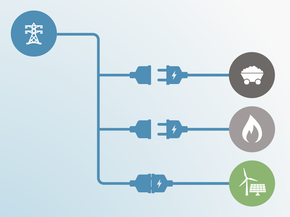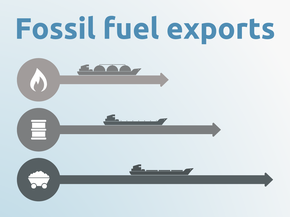Current Policy Projections
Economy-wide
It is difficult to assess whether Saudi Arabia’s current policy projections reach its NDC since there is no business-as-usual baseline available for the NDC (as discussed in the Pledge section) and there is limited data availability for the current policies trajectory. This is further explained in the Assumptions section. Based on these assumptions, we expect that under current policy projections, Saudi Arabia’s emissions to be at 1,124–1,185 GtCO2e by 2030—an almost six-fold increase from the 1990 level. Saudi Arabia may reach its “Critically insufficient” NDC target under current policies projections, as the lower range of the current policies scenario is slightly lower than the upper limit of the NDC target.
Energy supply
As the world’s leading oil exporter, oil extraction has been the backbone of Saudi economy, with proceeds from exports covering 90% of total government revenues, and contributing more than 35% of GDP since 1970 (Al-Rushaid, 2010; Alshahrani & Alsadiq, 2014). Given the current policy framework in the energy supply sector, Saudi Arabia is projected to follow baseline levels using fossil fuels to supply its energy needs.
However, facing an oversupply in the market with the recovery of supply production from Iran, Iraq and Libya, the development of new, unconventional, oil supplies, a less energy-intensive phase of Chinese and East-Asian growth and the gradual commercial viability of renewables, Saudi Arabia is increasingly steering its focus towards diversification from oil dependence (Alsweilem, 2015).
In addition to international pressure, Saudi Arabia has one of the world’s highest rates of per capita energy consumption, forecast to triple by 2030 compared to 2010 levels (Al-Ghabban, 2013). This issue presents two hitches: it will significantly reduce Saudi Arabia’s capacity to export oil because of increased domestic needs, and it will increase government spending because oil is heavily subsidised for domestic consumption.
In 2013, the government announced its plan to build 54 GW of renewable power and 17 GW of nuclear power by 2032 to cover 40–45% of future electricity production (Al-Ghabban, 2013). After already announcing an eight-year delay of these plans in 2015, Saudi Arabia has further revised the renewables energy targets in 2016. In the “Vision 2030” the target is cut down to an ‘initial phase’ of only 9.5 GW in 2023 (Borgmann, 2016; Kingdom of Saudi Arabia, 2016). Targets for the period post-2023 have not yet been announced. In this “Vision 2030” there is no further mention of the nuclear power target. Our current policy projections reflect a range of assumptions regarding the development of both renewable and nuclear power up to 2030. Compared to the initial plans, we project the new “Vision 2030” will result in additional emissions of 73–135 MtCO2 in 2030.
Through the National Renewable Energy Plan, Saudi Arabia is taking some steps to expand renewable electricity generation. In February 2017, it launched a US$30–50 billion renewable energy tender programme (Saudi-US Trade Group, 2017) through which domestic and international companies are invited to bid for renewable energy projects. In the first round, companies are bidding to develop 300 MW of solar energy and 400 MW of wind power projects (Bloomberg, 2017b). In October 2017, the prices for the first round of bids on solar energy looked set to break the prior record lows (2.42 US cents/kWh in Abu Dhabi). Seven out of eight bids were below 3 US cents/kWh and the lowest bid was 1.79 US cents/kWh (Bloomberg, 2017a). After detailed evaluation of material compliance with RFP requirements, Saudi Arabia’s Renewable Energy Project Development Office announced two short-listed firms with 2.34 US cents/kWh and 2.66 US cents/kWh (PVTech, 2018).
Transport
The government is currently seeking to diversify the economy beyond oil exports. Government officials are studying the feasibility of reviving those infrastructure and economic development projects—which were suspended because of low oil prices in 2016—that could achieve the objective of a more diversified economy (Reuters, 2017). Energy subsidy cuts are a key part of this reform plan that has started with an increase in fuel prices in December 2015, with the aim to reach international price levels by 2020. However, in December 2017 Saudi Arabia announced it would instead slow the pace of energy subsidy cuts to offset the impact of austerity measures on the stagnating economy. Saudi Arabia is now planning to gradually reach parity with international gasoline prices between 2018 and 2025. In the same period, Saudi Arabia plans to increase local diesel prices to 90% of international prices. It has also announced other energy types price increases (Bloomberg, 2017). We project that the updated energy subsidy cuts will result in emissions reductions of 53 MtCO2e compared to business-as-usual in 2030. The Government has also implemented a 5% VAT for fuel prices from January 2018 onwards (General Authority of Zakat & Tax, 2018). Another policy in the transport sector foresees fuel economy standards for imported vehicles by 2020 (IEA, 2017).
Buildings
In the building sector, Saudi Arabia has introduced energy efficiency measures such as insulation standards for new buildings, and tightened minimum energy performance standards for air conditioners (ACs) to reduce local oil consumption (IEA, 2014).. Since the introduction of these measures and standards in 2012, the standards for ACs have been further refined and the insulation standards continue to be enforced. Saudi Arabia is currently looking into developing standard for appliances and lighting. The measures and standards in the building sector are expected to reduce emissions (Saudi Arabia Energy Efficiency Center, 2017).
Further analysis
Latest publications
Stay informed
Subscribe to our newsletter







